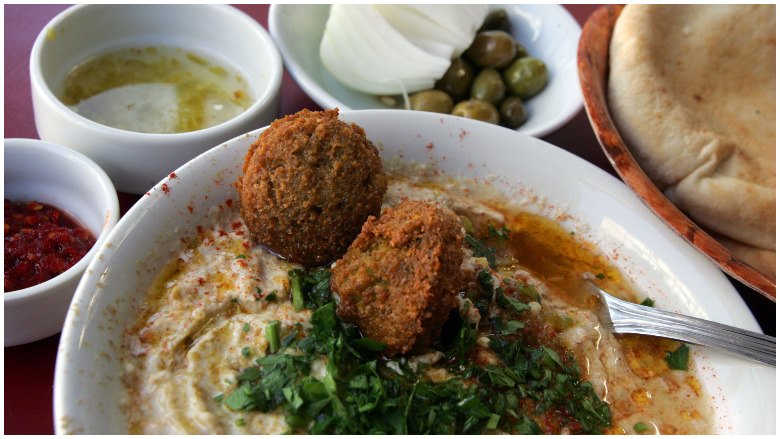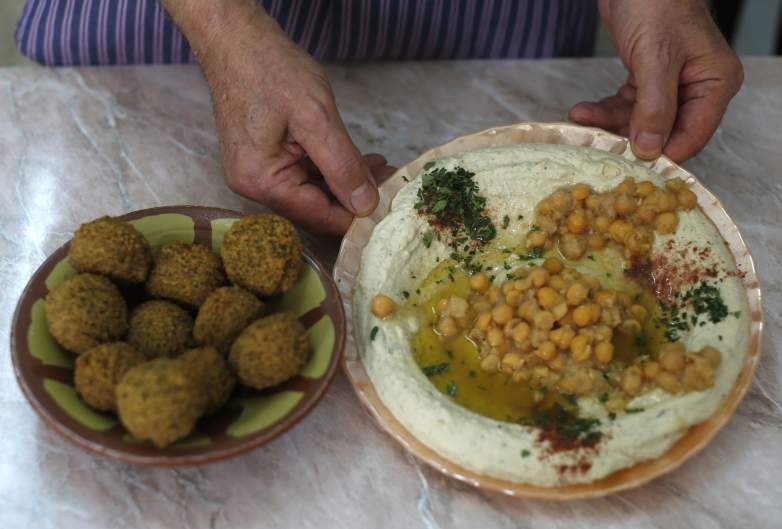
Getty Falafels.
The falafel, beloved in many countries, and described by Google as “the best thing that ever happened to chickpeas,” is the subject of a celebratory June 18, 2019 Google Doodle.
There’s always a lot of meaning layered into food. Culture. Family. Symbolism. And so it is with the falafel. Thus, the Google Doodle is celebrating a lot more than a fried ball. “Although the exact origins of this spicy street food have been lost to the mists of time, falafel has been enjoyed for centuries in many different cultures,” Google noted with the Doodle.
Here’s what you need to know about the falafel and its history:
1. The Falafel Is Often a Deep-Fried Chickpea or Fava Bean Ball

First of all, for those who haven’t tried them, what are you waiting for? A falafel is a “delicious deep-fried chickpea ball that is commonly paired with hummus,” according to Culture Trip. History Today describes the Falafel as being “made from ground fava (broad) beans, chickpeas or a mixture of the two.”
The dish is often served with pita bread, salad, and tahini-based sauces, according to Aladdin Houston. YnetNews reports that the falafel, although commonly shaped like a ball, sometimes takes on the form of a flat patty or burger. Its color can vary, and it can be smooth or grainy. Sometimes it’s folded inside a pita.
The site explains that the falafel is made from “soaked chickpeas, coriander, garlic, cumin, salt and pepper.” Sometimes other things are added to the falafel balls, such as onions, parsley and paprika, according to YnetNews.
2. The Origins of the Falafel Are Disputed But It Probably Developed in Egypt

GettyA Palestinian street vendor sells falafel at his stall during the holy Muslim fasting month of Ramadan in Gaza City on June 1, 2017.
The Culture Trip site reports that, although falafels are found in various countries today, including Israel, they originated in Egypt. The Christian Copts of Egypt weren’t supposed to eat meat during some holidays, so they developed what became the falafel: a food called ta’amiya that consisted of fava beans, according to Culture Trip.
According to History Today, though, the origins of the Falafel are often disputed, with different countries and cultures laying claim, and often the disputes fall along political lines. “While the Israelis have fêted it as one of their national dishes, the Palestinians are resentful of what they perceive as the ‘theft’ of a distinctly Arab speciality,” History Today reports. “Meanwhile, the Lebanese have tried to have it recognized as their own; even the Yemeni say it is they who invented it.”
Still, though, that site also acknowledges that the falafel probably came from Egypt; History Today claims it’s relatively modern, though, dating to the late 1880s. Thus, when it developed is also under dispute. Aladdin Houston says one theory holds that British officers in Egypt brought the food with them from India, where they “enjoyed fried vegetable croquettes.” That site says the first falafels were made in Alexandria.
3. Israel Touts the Falafel as a National Dish

Palestinian restaurant owner Yasser Taha displays a plate of hummus (R), a paste made from chickpeas, and a bowel of falafel which are made from mashed and fried chickpeas, at the Abu Shukri restaurant in the Old City of Jerusalem on September 12, 2015.
Despite the likely origins elsewhere, Israel has staked a claim to the falafel; it’s a national dish in that country, according to Haaretz.
Haaretz notes that, in Israel, the falafel can be found “everywhere and it is eaten by everyone in the country, rich and poor, young and old.”
Haaretz attributes the popularity of the falafel in Israel to Yemeni Jews, who popularized it in the 1950s. “They brought with them the chickpea version of the dish from Yemen and introduced the concept of serving falafel balls in pita bread,” the site explains.
The Israelis are responsible for the popularity of the dish in the United States, where it emerged in the 1970s, according to YnetNews.
4. Some Palestinians See the Falafel as an Arab Food

Lebanese chef Ramzi Choueiry holds a bucket of fried falafel balls before adding them to a larger plate in an attempt to set a new Guinness world record in Beirut on May 9, 2010. A day after regaining the world record for the largest plate of hummus, Lebanon set a new record for the largest serving of falafel that weighed 5,173 kilograms (about 11,400 pounds).
The falafel and its origins are caught up in the Israeli and Palestinian disputes, according to The New York Times.
“Many Palestinians believe that Israelis have stolen falafel, a traditional Arab food,” the newspaper reported. “We always sort of look at each other and roll our eyeballs when we pass a restaurant that says ‘Israeli falafel,'” said Rashid Khalidi, a Palestinian-American professor, to The Times.
What is clear, reports Real Clear History, is that the falafel is an “archetypically Middle Eastern dish.”
5. You Can Find Falafels in Many Countries

An Iraqi man prepares Falafel, traditional regional food, at a market in Baghdad 10 September 2005.
There are many places, especially in the Arab world, but now also throughout the globe, where you can find falafels as a common food choice.
“They are a common sight at foodstalls and restaurants from Aden to Istanbul, and from Baghdad to Benghazi,” explains Real Clear History.
In its Google Doodle, Google also noted the variety of cultures that embrace the falafel. “India produces the vast majority of the world’s chickpea crop, which currently is in high season. In Egypt, fava beans are ground to make these delicious, crispy balls of fried plant protein, known in Egypt as ‘ta’amiya.’ Israel has a song to celebrate its love affair with the tried-and-true treat, entitled And We Have Falafel,” explained Google.